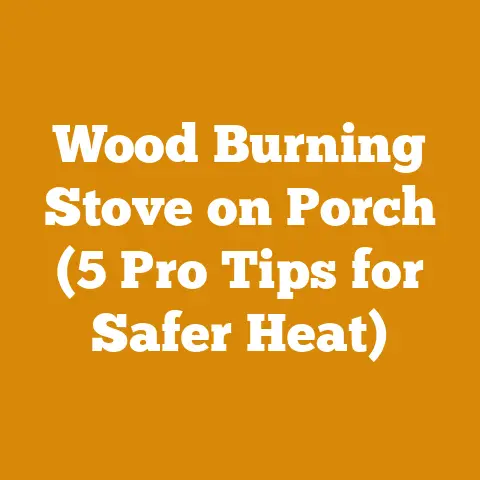How Much to Grind a Tree Stump (7 Pro Tips from Experts)
Let’s dive into the nitty-gritty of stump grinding, shall we?
How Much to Grind a Tree Stump (7 Pro Tips from Experts)
Staring at a tree stump in your yard is like having a persistent houseguest who’s overstayed their welcome. It’s unsightly, it gets in the way of landscaping, and it’s a potential home for unwanted critters. The good news is, you don’t have to live with it forever. Stump grinding is the solution, but knowing how much to grind is key. It’s not just about making the stump disappear; it’s about doing it right, safely, and effectively.
Globally, the landscaping and tree service industries are booming. According to a report by Global Market Insights, the landscaping services market alone was valued at over $100 billion in 2023 and is projected to grow significantly in the coming years. This growth is fueled by increased urbanization and a growing desire for aesthetically pleasing outdoor spaces. Within this sector, stump grinding is a vital service, offering a practical solution to the eyesore and inconvenience left behind after tree removal.
In my years of experience working with wood, from felling trees to milling lumber and processing firewood, I’ve learned that proper preparation is everything. Grinding a stump is no different. It’s not simply a matter of pointing a machine at a problem and hoping for the best. It’s about understanding the process, having the right tools, and knowing how to use them effectively.
Why Bother Grinding a Stump Anyway?
Before we get into the “how much,” let’s address the “why.” You might be thinking, “Can’t I just leave it there?” Well, technically, yes, you can. But here’s why you probably shouldn’t:
- Aesthetics: Let’s face it, stumps aren’t pretty. They detract from the overall look of your property.
- Safety: Stumps can be tripping hazards, especially for kids playing in the yard.
- Pest Control: Decaying wood attracts insects like termites and ants, which can then spread to your home.
- Regrowth: Some tree species will stubbornly try to regrow from the stump, leading to unwanted sprouts.
- Landscaping Limitations: A stump prevents you from planting new trees, shrubs, or even just laying down sod.
7 Pro Tips for Grinding Tree Stumps
Okay, now that we’ve established the importance of stump grinding, let’s get down to brass tacks. Here are seven pro tips to help you determine how much to grind, ensuring a successful and satisfying outcome.
1. Assess the Situation: Understand the Stump and Your Goals
Before you even think about firing up a stump grinder, take a good, hard look at the situation. This is where your prep work really pays off.
- Identify the Tree Species: Knowing the species helps you understand the root system. Some trees, like oaks, have deep taproots, while others, like willows, have shallow, spreading roots. This will influence how far down and out you need to grind.
- Measure the Stump: Note the diameter and height of the stump. This gives you a baseline for determining the volume of wood you’ll need to remove.
- Consider Future Land Use: What are your plans for the area after the stump is gone? Are you planting grass, putting in a garden, or building a patio? This is the most critical factor in determining how deep you need to grind.
- Check for Utilities: Before doing anything, call 811 (in the US and Canada) or your local equivalent to have underground utilities marked. Hitting a gas line or electrical cable is a disaster you absolutely want to avoid. This is an absolute must; no exceptions.
- Evaluate the Surrounding Area: Are there fences, buildings, or other obstacles nearby? This will affect the type of stump grinder you can use and how easily you can maneuver it.
Example: I once had a client who wanted to build a small deck over the area where a large oak tree had been removed. Because of this, I had to grind the stump much deeper (about 18 inches below grade) than I would have for a simple lawn replanting (6-8 inches).
2. Determine the Ideal Grinding Depth: The Key to Success
This is the million-dollar question: how deep should you grind? The answer depends on your future plans for the area.
- Planting Grass or Ground Cover: 6-8 inches below ground level is generally sufficient. This allows enough room for topsoil and root growth.
- Planting Shrubs or Small Trees: 12-18 inches is a good target. This provides enough space for the root ball of most shrubs and small trees.
- Planting Large Trees: 24-36 inches is recommended. This gives the new tree’s roots plenty of room to establish themselves.
- Building a Patio or Deck: 18-24 inches is usually necessary to ensure a stable base. You may need to go deeper depending on the specific construction requirements.
- Total Stump Removal: If you want to completely eliminate the stump and all its roots, you’ll need to grind as deep and wide as possible. This can be a labor-intensive process, and it may be more cost-effective to excavate the entire area.
Data Point: A study by the University of Minnesota Extension found that grinding stumps to a depth of 8 inches was sufficient for successful grass establishment in 90% of cases. However, for planting trees, a depth of at least 18 inches was recommended.
3. Choose the Right Stump Grinder: Power and Maneuverability Matter
Stump grinders come in various shapes and sizes, each with its own advantages and disadvantages. Selecting the right one is crucial for efficiency and safety.
- Handheld Stump Grinders: These are small, lightweight machines ideal for small stumps (less than 12 inches in diameter) and tight spaces. They’re relatively inexpensive but can be tiring to operate for extended periods.
- Tow-Behind Stump Grinders: These are larger, more powerful machines that can handle larger stumps (up to 24 inches in diameter). They’re towed behind a vehicle and offer good maneuverability.
- Self-Propelled Stump Grinders: These are the workhorses of the stump grinding world. They’re powerful, self-propelled, and can handle stumps of virtually any size. However, they’re also the most expensive and require some skill to operate.
- Excavator-Mounted Stump Grinders: These are industrial-grade attachments for excavators, used for large-scale land clearing projects.
Pro Tip: Renting a stump grinder is often more cost-effective than buying one, especially if you only have a few stumps to remove. Rental rates typically range from $100 to $500 per day, depending on the size and type of machine.
When choosing a stump grinder, consider these factors:
- Stump Size: Match the grinder’s cutting capacity to the size of the stump.
- Terrain: Consider the terrain around the stump. Is it flat and smooth, or uneven and rocky?
- Accessibility: Can you easily get the grinder to the stump? Are there any obstacles in the way?
- Power Source: Stump grinders are powered by either gasoline or electricity. Gasoline-powered grinders are more powerful and portable, while electric grinders are quieter and produce fewer emissions.
- Safety Features: Look for grinders with features like safety guards, emergency shut-off switches, and anti-vibration handles.
4. Prepare the Area: Safety First
Before you start grinding, take the time to prepare the area around the stump. This is not just about making the job easier; it’s about ensuring your safety and preventing damage to your property.
- Clear the Area: Remove any rocks, branches, or other debris from around the stump. These objects can become projectiles when hit by the grinder’s cutting wheel.
- Mark Underground Utilities: As mentioned earlier, this is crucial. Call 811 or your local equivalent to have underground utilities marked.
- Protect Surrounding Structures: Cover nearby fences, buildings, or other structures with tarps or plywood to protect them from flying debris.
- Wear Appropriate Safety Gear: This includes safety glasses, hearing protection, gloves, and sturdy boots. A face shield is also a good idea.
- Establish a Safety Zone: Keep bystanders and pets away from the work area. A radius of at least 50 feet is recommended.
Personal Story: I once saw a guy grinding a stump without wearing safety glasses. A small piece of wood flew up and hit him in the eye. He ended up in the emergency room. Don’t be that guy. Safety gear is not optional; it’s essential.
5. The Grinding Process: A Step-by-Step Guide
Now it’s time to get your hands dirty. Here’s a step-by-step guide to grinding a tree stump:
- Position the Grinder: Place the grinder so that the cutting wheel is directly over the stump.
- Start the Engine: Follow the manufacturer’s instructions for starting the grinder.
- Engage the Cutting Wheel: Slowly lower the cutting wheel onto the stump.
- Sweep the Wheel: Move the cutting wheel back and forth across the stump in a sweeping motion.
- Adjust the Depth: As you grind, gradually lower the cutting wheel to the desired depth.
- Grind the Roots: Once you’ve ground the main part of the stump, move the grinder around the perimeter to grind any visible roots.
- Repeat as Needed: Continue grinding until the stump is completely removed to the desired depth.
- Shut Down the Grinder: Once you’re finished, disengage the cutting wheel, shut off the engine, and allow the grinder to cool down before moving it.
Technical Requirement: Most stump grinders have a cutting wheel that rotates at speeds of up to 3,000 RPM. This is why it’s so important to wear safety gear and keep bystanders away from the work area.
6. Dealing with the Debris: Cleanup is Key
Grinding a stump creates a lot of wood chips and debris. It’s important to clean up this mess properly.
- Rake the Area: Use a rake to gather the wood chips and debris.
- Dispose of the Debris: You can either haul the debris away or use it as mulch in your garden. Wood chips make excellent mulch for shrubs and flower beds.
- Fill the Hole: Fill the hole left by the stump with topsoil.
- Compact the Soil: Use a tamper to compact the soil.
- Seed or Sod: Plant grass seed or lay down sod to restore the area to its original condition.
Case Study: A local landscaping company found that using wood chips from stump grinding as mulch reduced their need for purchased mulch by 20%, saving them thousands of dollars per year.
7. Troubleshooting: Common Problems and Solutions
Even with the best preparation, things can sometimes go wrong. Here are some common problems and their solutions:
- The Grinder Won’t Start: Check the fuel level, spark plug, and air filter. Make sure the engine switch is in the “on” position.
- The Cutting Wheel is Dull: Sharpen or replace the cutting teeth. Dull teeth can make the grinding process slow and difficult.
- The Grinder is Vibrating Excessively: Check for loose bolts or damaged parts.
- The Grinder is Overheating: Allow the engine to cool down before continuing.
- The Stump is Too Large for the Grinder: Consider renting a larger grinder or hiring a professional.
Pitfalls to Avoid:
- Rushing the Job: Take your time and work carefully. Rushing can lead to mistakes and injuries.
- Ignoring Safety Precautions: Always wear appropriate safety gear and keep bystanders away from the work area.
- Not Checking for Underground Utilities: This is a potentially fatal mistake. Always call 811 or your local equivalent before digging.
- Using the Wrong Type of Grinder: Choose a grinder that is appropriate for the size and type of stump you’re dealing with.
- Not Maintaining the Grinder: Keep the grinder clean and properly maintained. This will prolong its life and improve its performance.
Costs and Budgeting Considerations
Stump grinding costs vary depending on several factors, including:
- Stump Size: Larger stumps require more time and effort to grind, so they cost more.
- Stump Location: Stumps that are difficult to access will cost more to grind.
- Tree Species: Some tree species are harder to grind than others.
- Grinding Depth: Grinding deeper will cost more.
- Professional vs. DIY: Hiring a professional will cost more than doing it yourself.
Cost Estimates:
- DIY Rental: Renting a stump grinder typically costs between $100 and $500 per day.
- Professional Grinding: Hiring a professional stump grinding service typically costs between $100 and $400 per stump, depending on the size and location.
Budgeting Tips:
- Get Multiple Quotes: If you’re hiring a professional, get quotes from several different companies.
- Factor in Rental Costs: If you’re renting a grinder, factor in the cost of fuel, transportation, and any other supplies you’ll need.
- Consider Disposal Costs: If you’re hauling away the debris, factor in the cost of disposal.
- Be Prepared for Unexpected Expenses: There’s always a chance that you’ll encounter unexpected problems, so it’s a good idea to have a little extra money set aside.
Next Steps and Additional Resources
Now that you know how much to grind a tree stump, you’re ready to tackle the job yourself or hire a professional. Here are some additional resources to help you along the way:
- Local Tree Service Companies: Search online for tree service companies in your area.
- Equipment Rental Companies: Check your local equipment rental companies for stump grinders.
- University Extension Services: Your local university extension service can provide valuable information about tree care and stump removal.
- Online Forums and Communities: Join online forums and communities dedicated to landscaping and tree care. You can ask questions, share tips, and learn from other enthusiasts.
Suppliers of Logging Tools:
- Bailey’s: A leading supplier of logging tools, chainsaws, and forestry equipment.
- Northern Tool + Equipment: Offers a wide range of tools and equipment for various applications, including logging and tree care.
- Forestry Suppliers, Inc.: Specializes in forestry, wildlife, and environmental science equipment.
Drying Equipment Rental Services:
- While not directly related to stump grinding, if you plan to use the wood chips for firewood, consider renting a wood kiln to speed up the drying process. Check with local equipment rental companies for availability.
Conclusion: A Stump-Free Future
Grinding a tree stump is a satisfying way to reclaim your yard and create a more beautiful and functional outdoor space. By following these seven pro tips, you can ensure a successful and safe stump grinding experience. Remember to assess the situation, choose the right grinder, prepare the area, grind carefully, clean up the debris, troubleshoot any problems, and factor in the costs. With a little planning and effort, you can say goodbye to that unsightly stump and hello to a stump-free future! After all, a job worth doing is worth doing well, right? Now, get out there and make that stump disappear!






